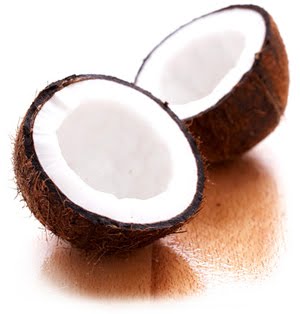What to buy now: Coconuts
Crack one open for noshing and sipping
 Coconuts are one of the hottest new food trends. You can now buy coconut water, coconut milk, coconut oil, dried coconut chips, and lots of other coconut goodies at grocery stores across the country.
Coconuts are one of the hottest new food trends. You can now buy coconut water, coconut milk, coconut oil, dried coconut chips, and lots of other coconut goodies at grocery stores across the country.
But our advice is to go straight to the produce aisle for fresh coconuts. There are two types. The familiar, brown-shelled mature ones have dense, thick meat that adds chewy texture to salsas, salads, and curries. The shredded flesh can also be boiled into coconut milk to add richness to curries, sauces, and soups.
Also be on the lookout for the hut-shaped young coconut, which has a green husk and is filled with lots of sweet water for sipping – just make an opening at the top and insert a straw. Those coconuts have a delicate, jellylike flesh, which can also be scooped into salsas and curries.
Meaty coconut flesh (fresh or dried) is a good source of potassium, is high in fiber, and packs essential minerals, but it’s not exactly diet food. It’s high in saturated fat and calories (about 140 per half cup), so eat it in moderation.
A heart-healthier alternative to eating coconut flesh is drinking coconut water, which is fat-free, low in calories, and packed with more potassium per serving than a banana. It’s a smart and refreshing way to hydrate on a hot day or after a moderate workout. When shopping for coconuts, keep these pointers in mind:
- Pick a good one. Listen for a sloshing sound inside, which indicates the coconut hasn’t cracked and leaked. The three indented “eyes” at the end of a mature coconut should be firm and mold-free.
- Size it right. If it’s heavy for its size, that’s a sure sign of freshness.
- Store it right. Keep coconuts unopened at room temperature for two weeks, or a month in the fridge. Refrigerate young coconuts in plastic wrap for up to a week.
- Prep like a pro. Place mature coconuts in a 325°F oven for about 20 minutes to help loosen the meat and shell; cool and crack open with a hammer on a newspaper-lined work area. To open a young coconut, use a cleaver to hack off its pointed top. Drink the water and scrape out the tasty pulp with a spoon.
DIY Coconut Milk
Lori Longbotham, author of “Luscious Coconut Desserts” (Chronicle Book, 2009), uses a ratio of 4 parts meat to 3 parts boiling water. Grate meat in a food processor. With the motor running, add water; process until slushy. Steep 25 minutes; strain through a cheesecloth, squeezing out as much liquid as possible.
Chef’s trick: Chips and salsa
Chef Daniel Orr, likes to use every bit of the coconut: To make a tropical salsa he mixes chopped coconut meat, mango, pineapple, tomato, mint, cilantro, red onion, and chili pepper with enough coconut water to bind. To make coconut chips, he thinly shaves the meat, tosses it with oil and salt, and roasts it in the oven until golden. The chips make a terrific garnish for steamed basmati rice or other Asian- and Caribbean-inspired dishes. He also recycles the empty shell halves into serving dishes after running them through a dishwasher.

